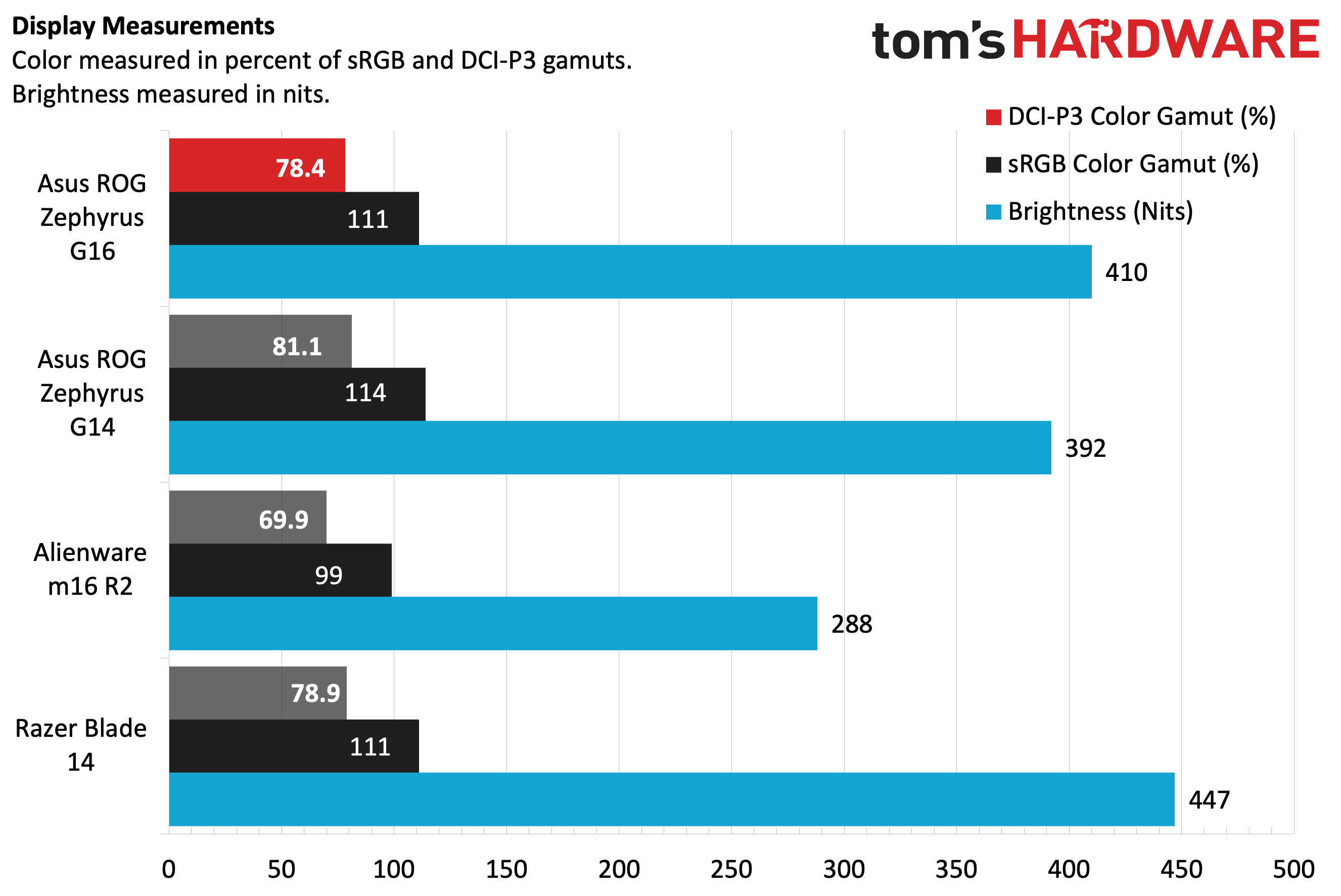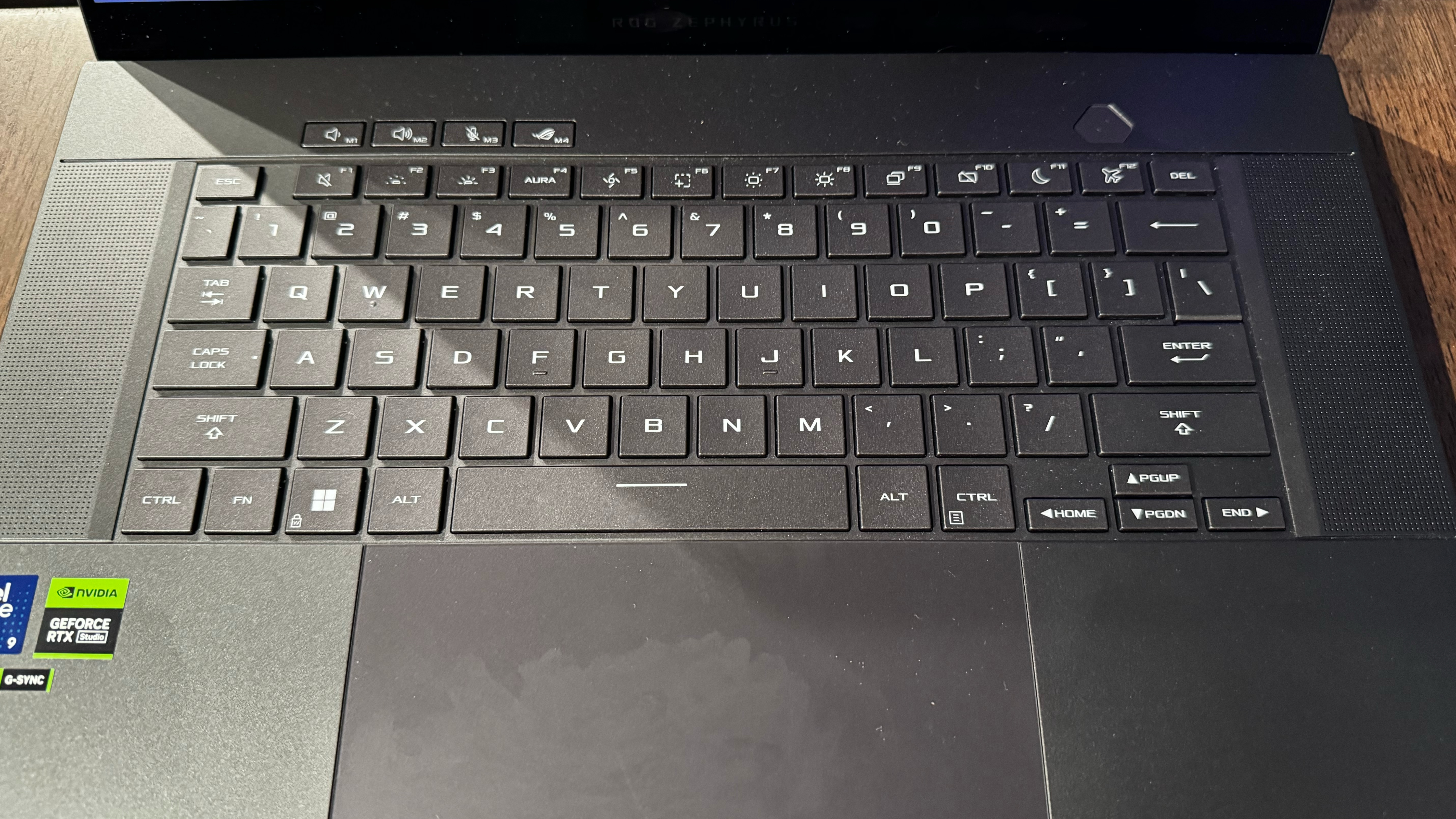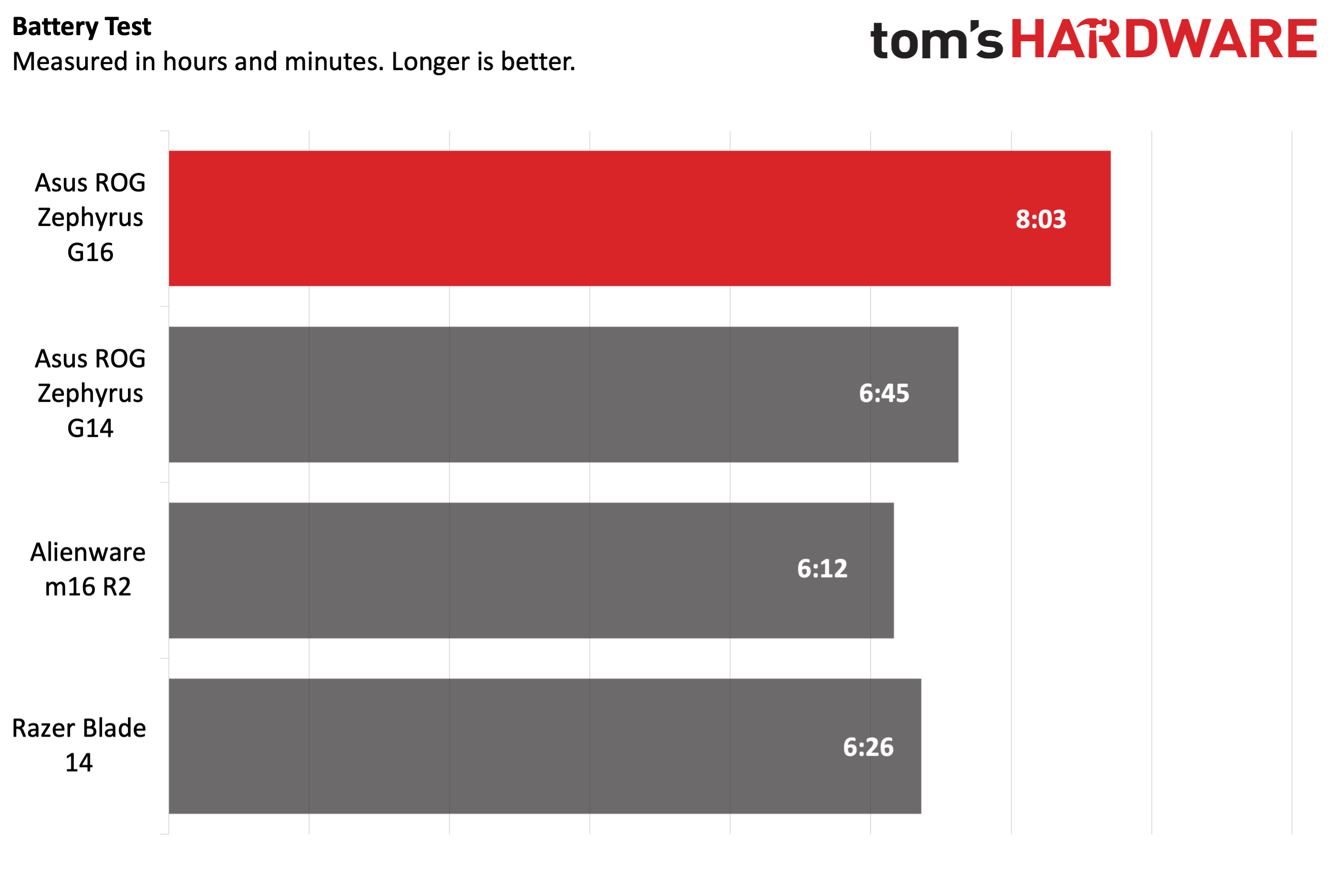Tom's Hardware Verdict
The ROG Zephyrus G16 is a pricey system with excellent audio, but its low-wattage GPU (for an RTX 4090, anyway) leads to missteps in gaming performance.
Pros
- +
Attractive, minimalist exterior
- +
Superb 6-speaker audio system
- +
Bright and colorful OLED display
Cons
- -
Inconsistent gaming performance with 115W RTX 4090
- -
Productivity performance is just average
- -
Pricey at $3,300
- -
Didn't run Borderlands 3 benchmark
Why you can trust Tom's Hardware
Gaming laptops are more powerful than ever. Today’s best gaming laptops pack incredible power in the CPU and discrete graphics. In theory, that appears to be the case with the Asus ROG Zephyrus G16, which features a range-topping Intel Core Ultra 9 185H processor and Nvidia’s flagship GeForce RTX 4090 GPU.
In addition, the ROG Zephyrus G16 has a 16-inch 2560 x 1600 OLED panel and weighs in at a relatively svelte 4.08 pounds. With a sleek aluminum chassis, six speakers, and a big 90 Whr battery, the ROG Zephyrus G16 doesn’t come cheap with a $3,299 price tag as configured. In addition, the thin and light design means that Asus limits the RTX 4090 to 115W, which limits maximum performance.
Design of the Asus ROG Zephyrus G16
Our review unit is a 16-inch laptop with a chassis finished in aluminum. The tolerances are tight, and the design is understated and professional-looking. It's not as daring as some of Asus' other ROG products, with the only real "standout" design twist being an etched line with LEDs that runs diagonally across the lid. There’s also an Asus Republic of Gamers logo in the corner of the lid. However, the system is equipped with a one-zone RGB keyboard that is customizable using Asus' Armoury Crate software.
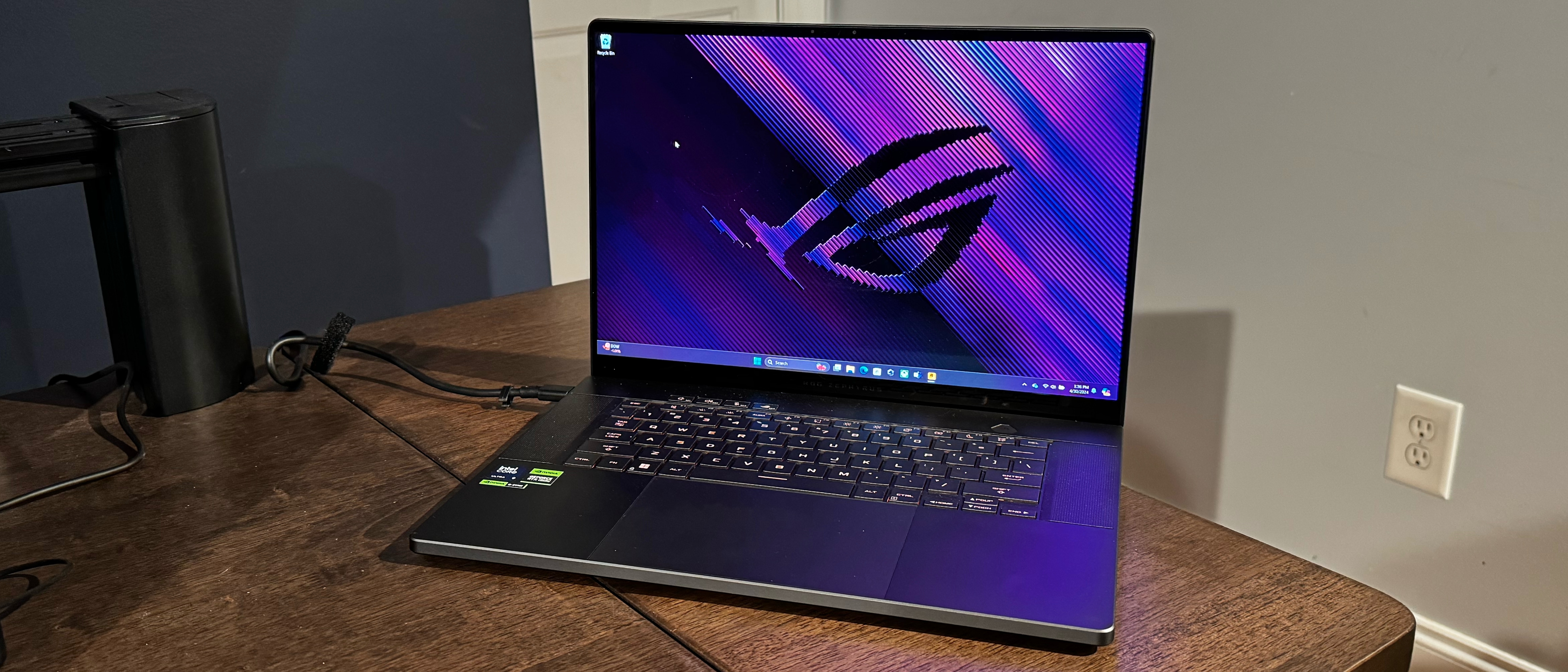
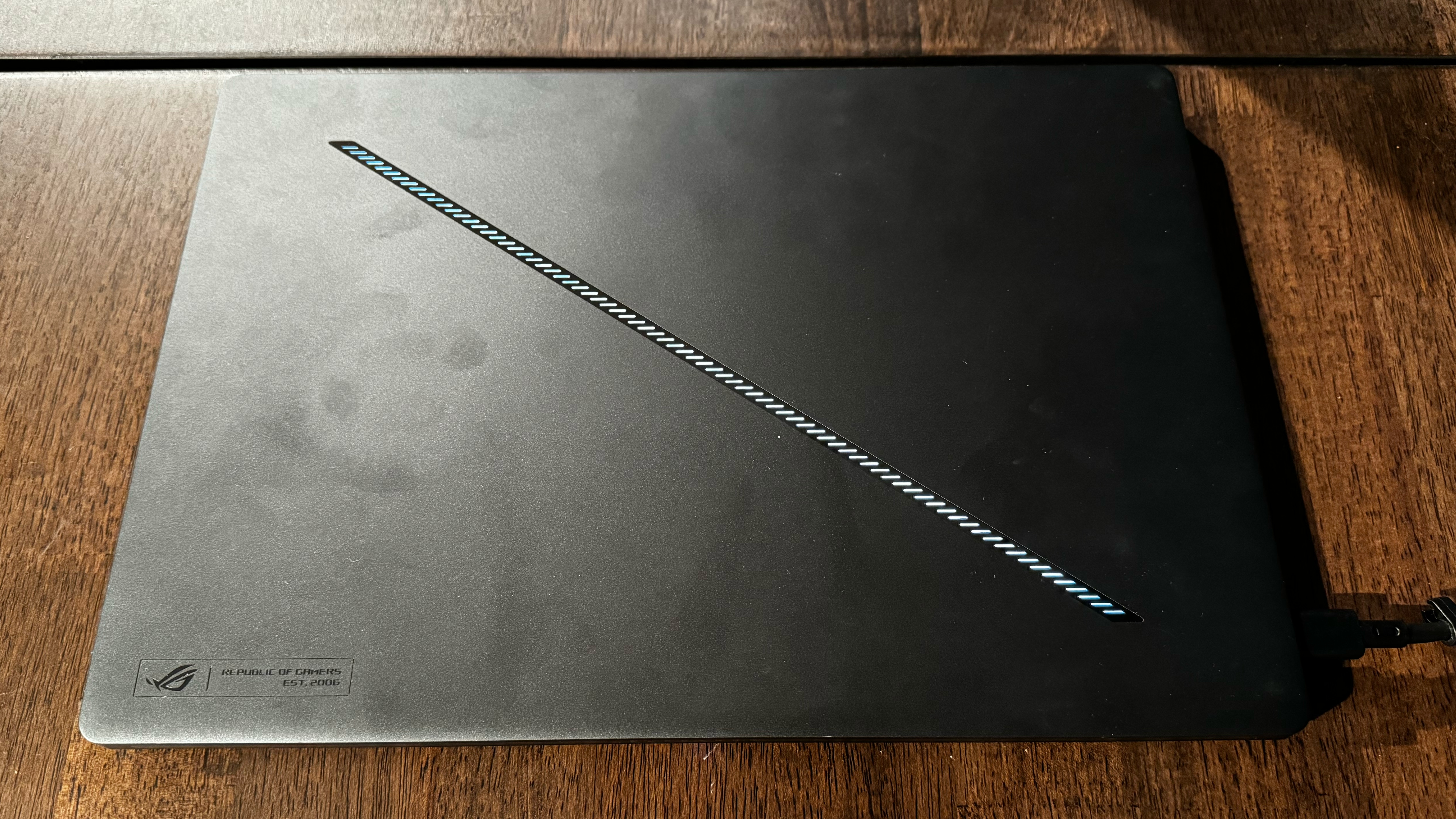

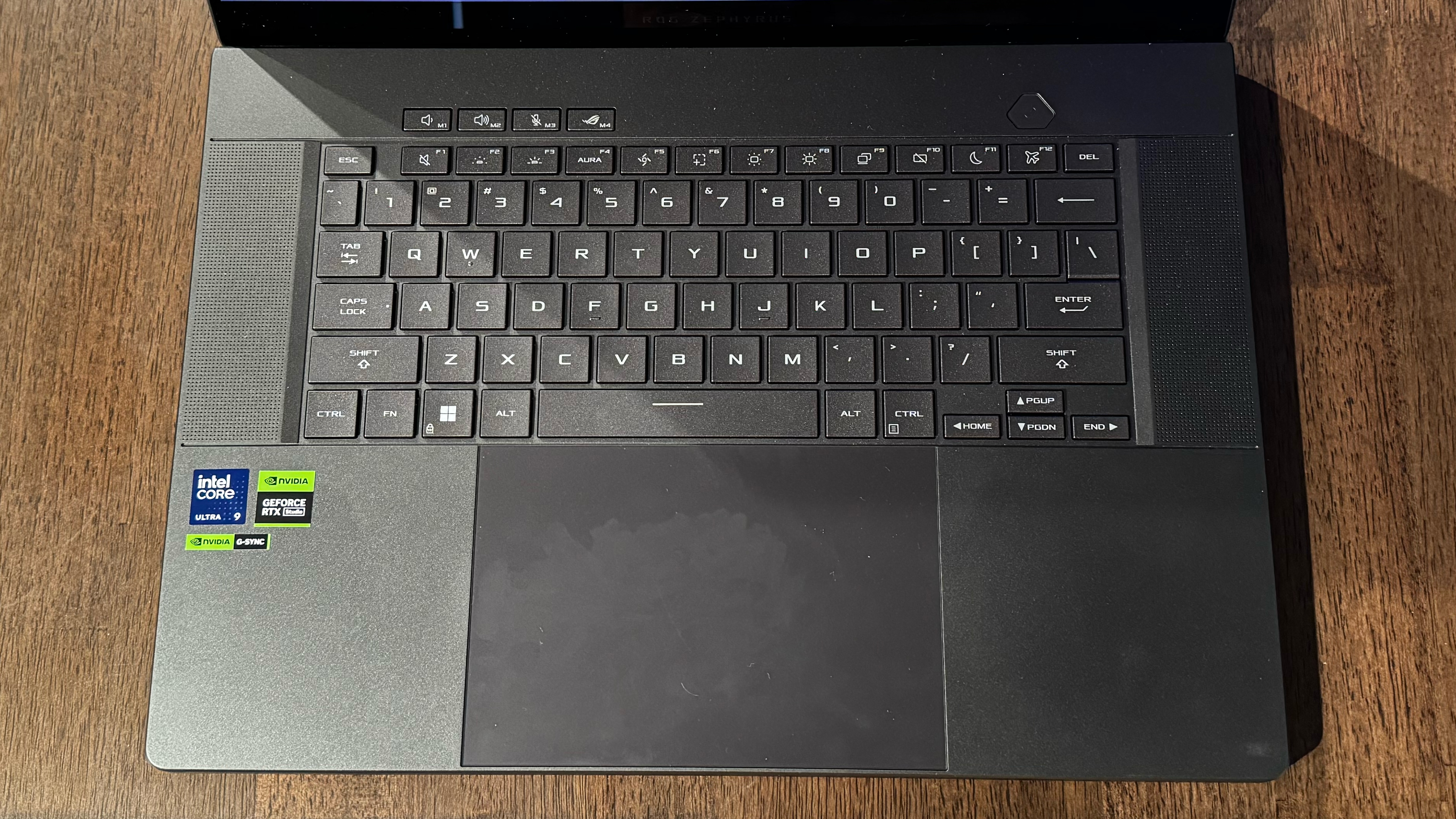
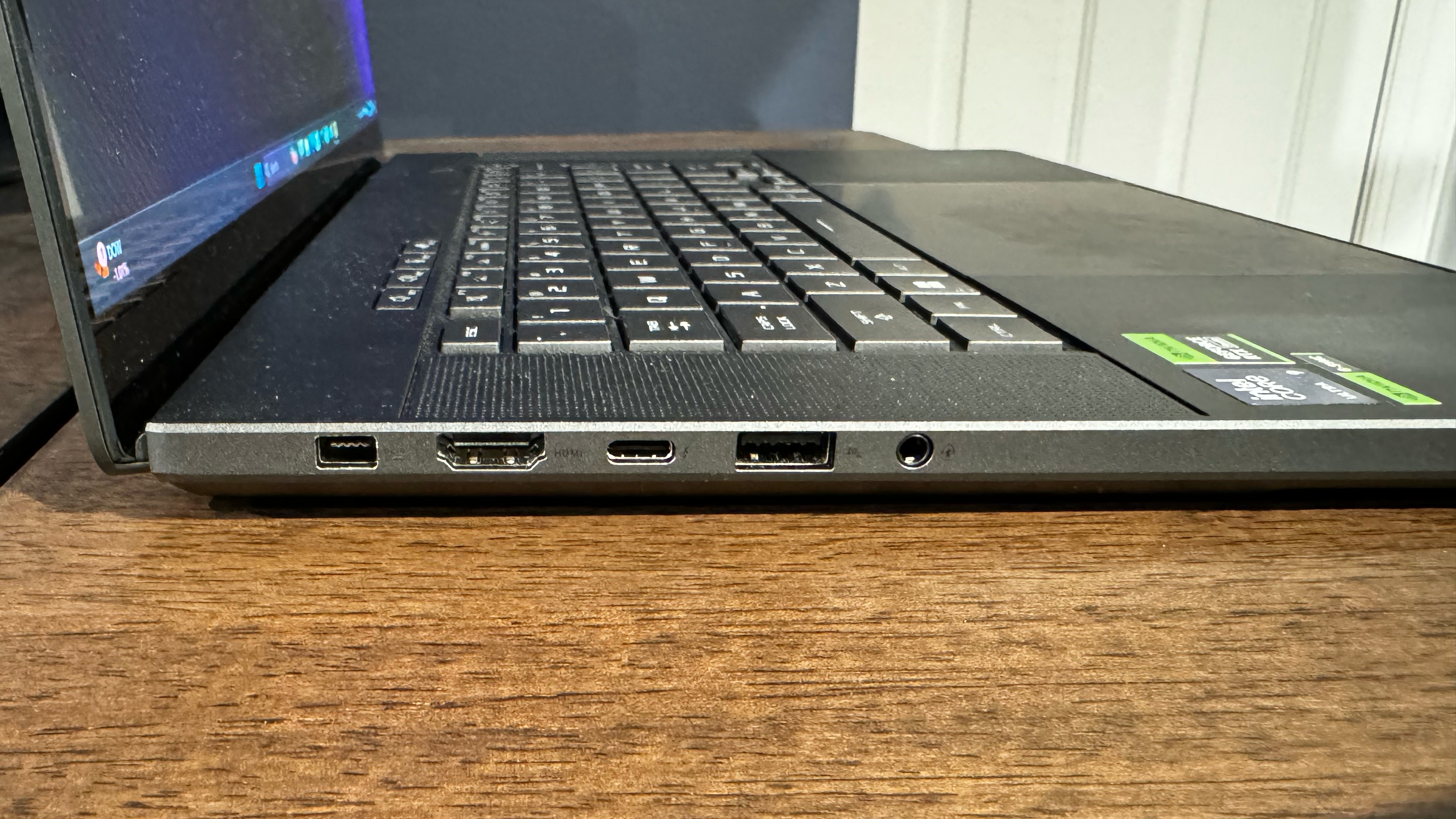
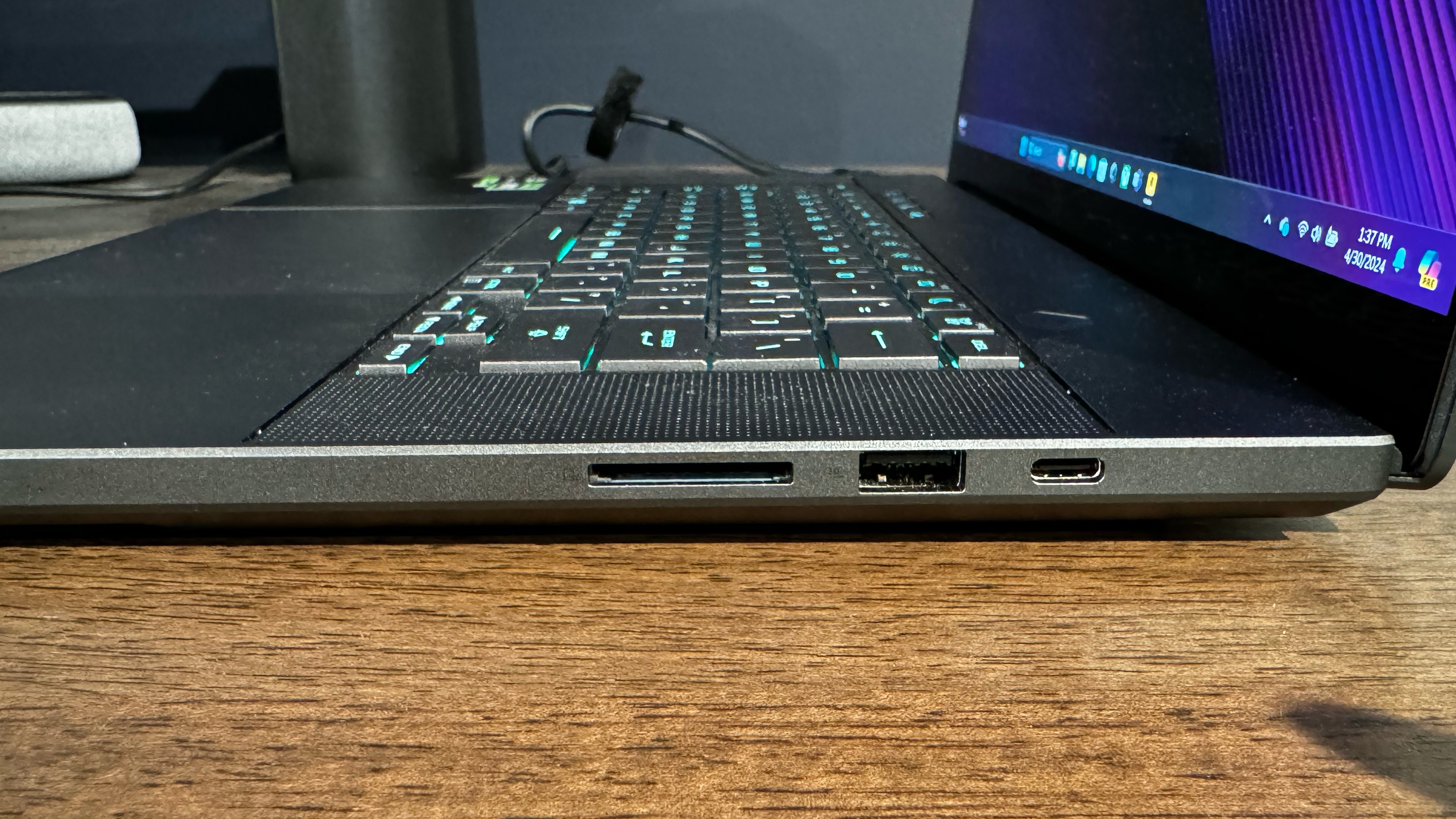
The right side of the chassis features a USB 3.2 Gen 2 Type-C port, one USB 3.2 Gen 2 Type-A port, and a full-size UHS-II card reader (312 MB/sec). On the left side, there's a proprietary input port for the 200-watt power adapter, an HDMI 2.1 port, a Thunderbolt 4 port, a USB 3.2 Gen 2 Type-A port, and a 3.5mm combo audio jack.
Despite its generous 16-inch chassis and flagship-level hardware onboard, the ROG Zephyrus G16 only weighs 4.08 pounds, with dimensions of 13.94 x 9.69 x 0.64 inches (width x depth x height). The ROG Zephyrus G14 is 12.24 x 8.66 x 0.64 inches and 3.31 pounds, while the Alienware m16 R2 is 14.33 x 9.81 x 0.93 inches and 5.75 pounds. Finally, the smaller, 14-inch Razer Blade 14 comes in at 12.23 x 8.97 x 0.7 inches and weighs 4.05 pounds.
Asus ROG Zephyrus G16 Specifications
| CPU | Intel Core Ultra 9 185H |
| Graphics | Nvidia GeForce RTX 4090 Laptop GPU (16GB GDDR6, 115W max graphics power, 1,700 MHz max boost clock |
| Memory | 32GB LPDDR5x-7467 |
| Storage | 2TB PCIe 4.0 NVMe SSD |
| Display | 16-inch, 2560 x 1600, OLED, 16:10, 240 Hz, G-Sync, Dolby Vision HDR |
| Networking | Intel Wi-Fi 6E AX211, Bluetooth 5.3 |
| Ports | USB 4 Type-C, USB 3.2 Gen 2 Type-C, 2x USB 3.2 Gen 2 Type-A, HDMI 2.1, SD card reader (UHS-II), 3.5 mm audio jack |
| Camera | 1080p, IR |
| Battery | 90 WHrs |
| Power Adapter | 200 W |
| Operating System | Windows 11 Pro |
| Dimensions (WxDxH) | 13.94 x 9.69 x 0.68 inches (354 x 246 x 172 mm) |
| Weight | 4.08 pounds, 1.85 kg |
| Price (as configured) | $3,299.99 |
Gaming and Graphics on the Asus ROG Zephyrus G16
Our ROG Zephyrus G16 review unit has an Intel Core Ultra 9 185H processor, 32GB of LPDDR5x-7467 memory, and a GeForce RTX 4090 discrete laptop GPU. The maximum graphics power for the RTX 4090 is 115 watts. Keep that power figure in mind as we delver deeper into the gaming benchmarks.
The assembled competition ‑ Asus ROG Zephyrus G14 (Ryzen 9 8945HS, 90-watt RTX 4070, 1800p), Alienware m16 R2 (Core Ultra 7 155H, 140-watt RTX 4070, 1600p), and Razer Blade 14 (Ryzen 9 8945HS, 140-watt RTX 4070, 1600p) ‑ feature lower-end CPUs and GPUs, but the gaming benchmarks were closer than you might think.
Get Tom's Hardware's best news and in-depth reviews, straight to your inbox.
I’m a sucker for the Grand Theft Auto franchise, with GTA 4 being my absolute favorite. I also occasionally like to revisit GTA V, which is still fun to play despite being over a decade old, thanks to the dynamic and always fresh content with GTA Online. At 2560 x 1600 resolution (Very High settings), I maintained a steady 150 fps across single-player and online sessions.
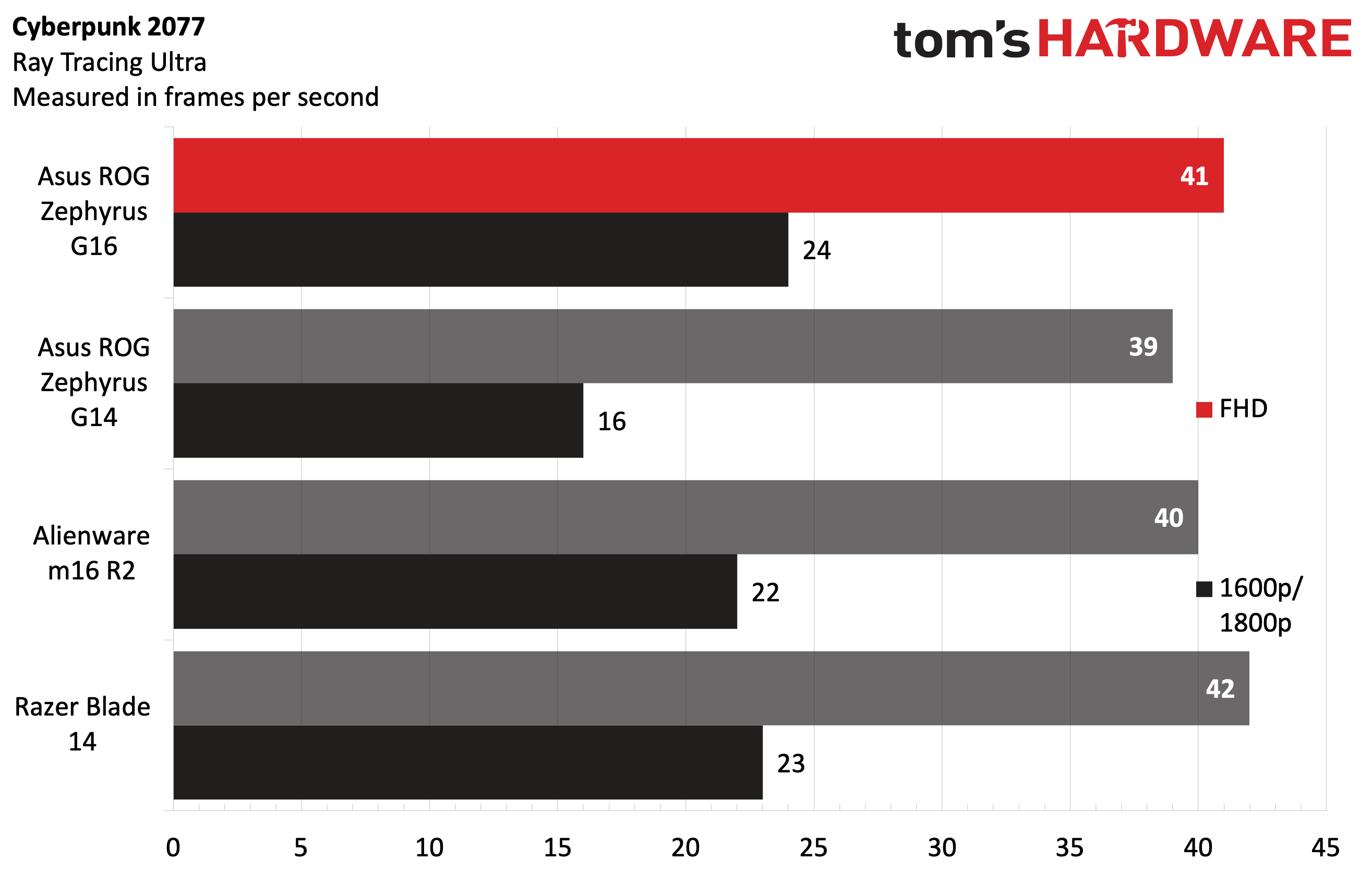
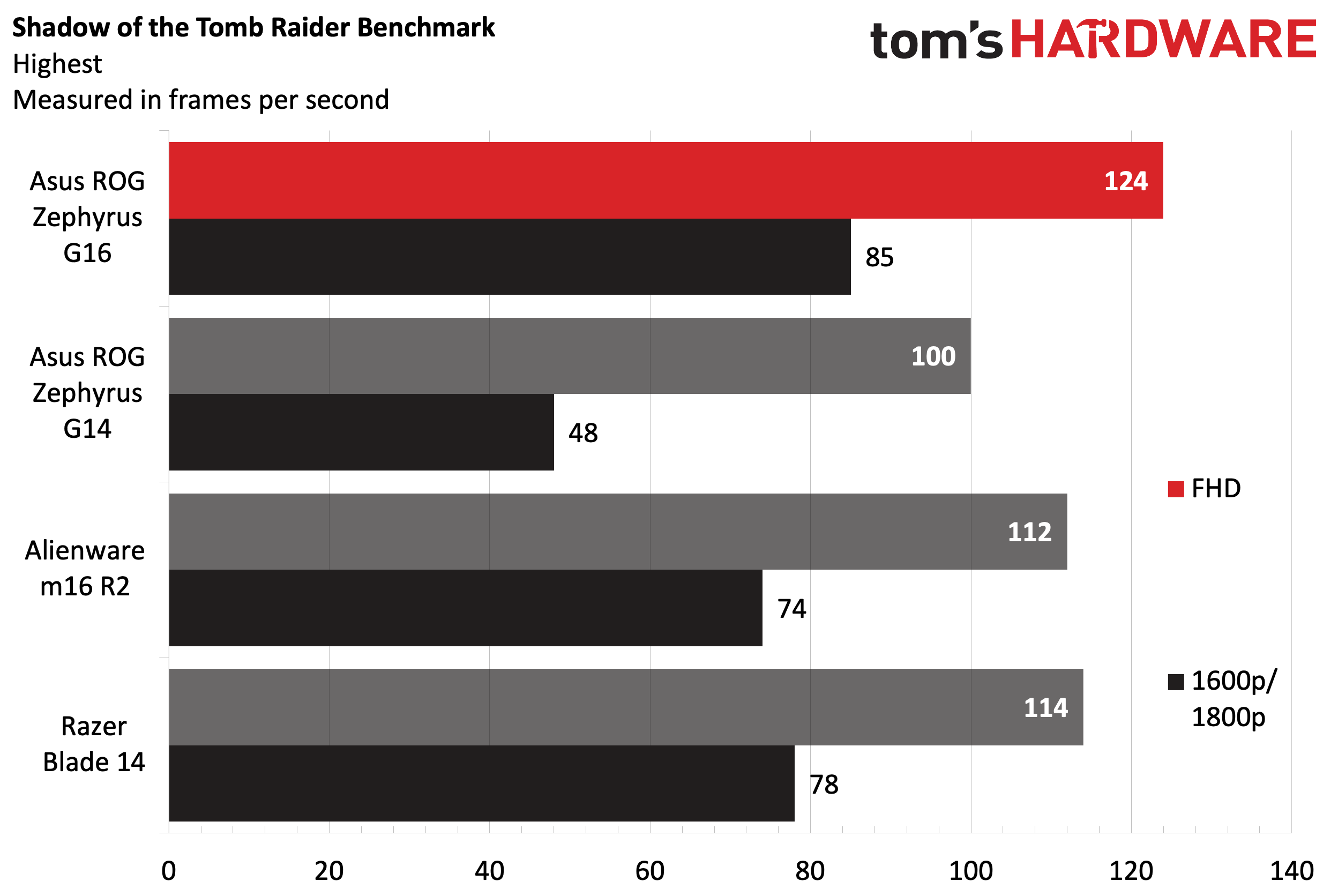
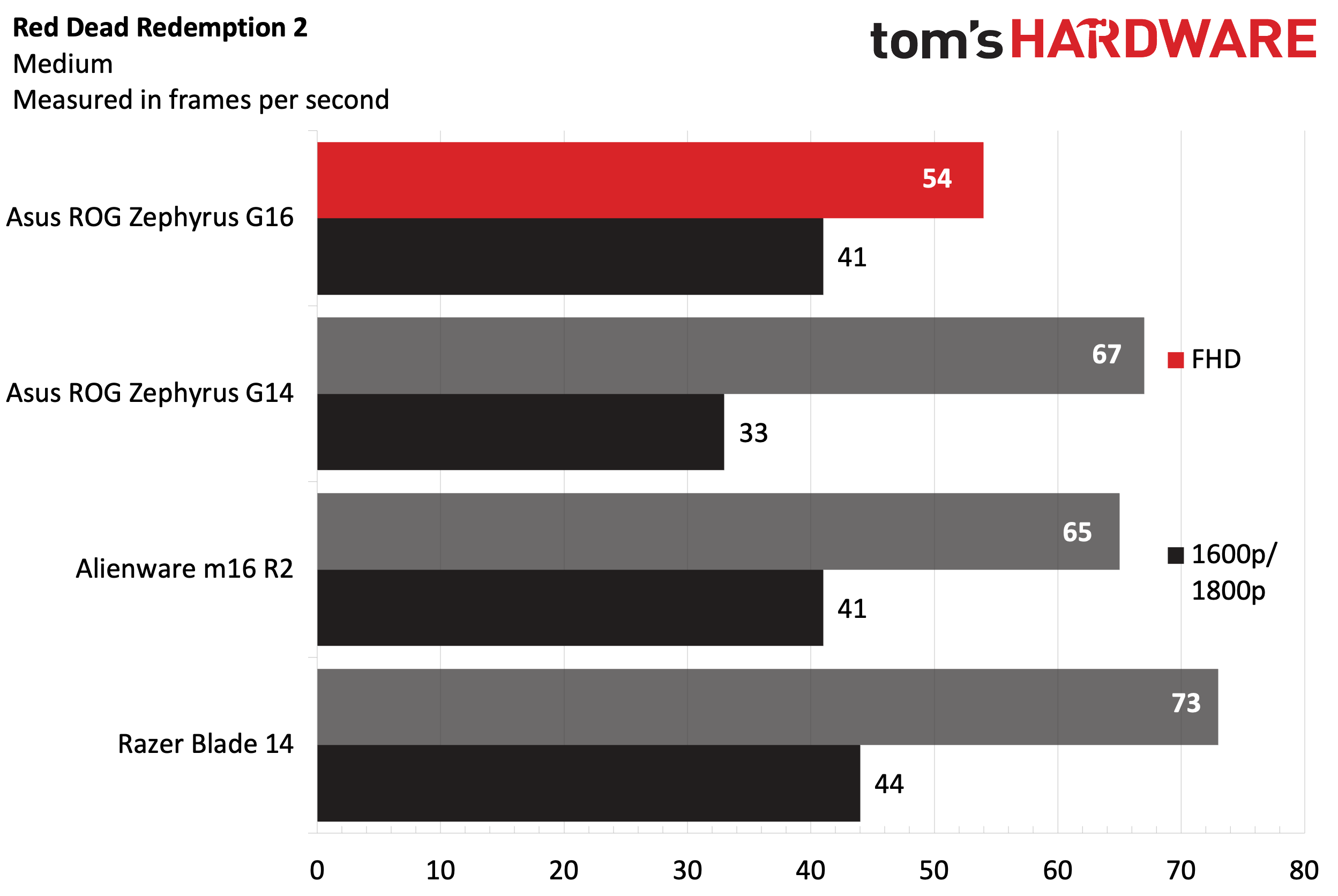
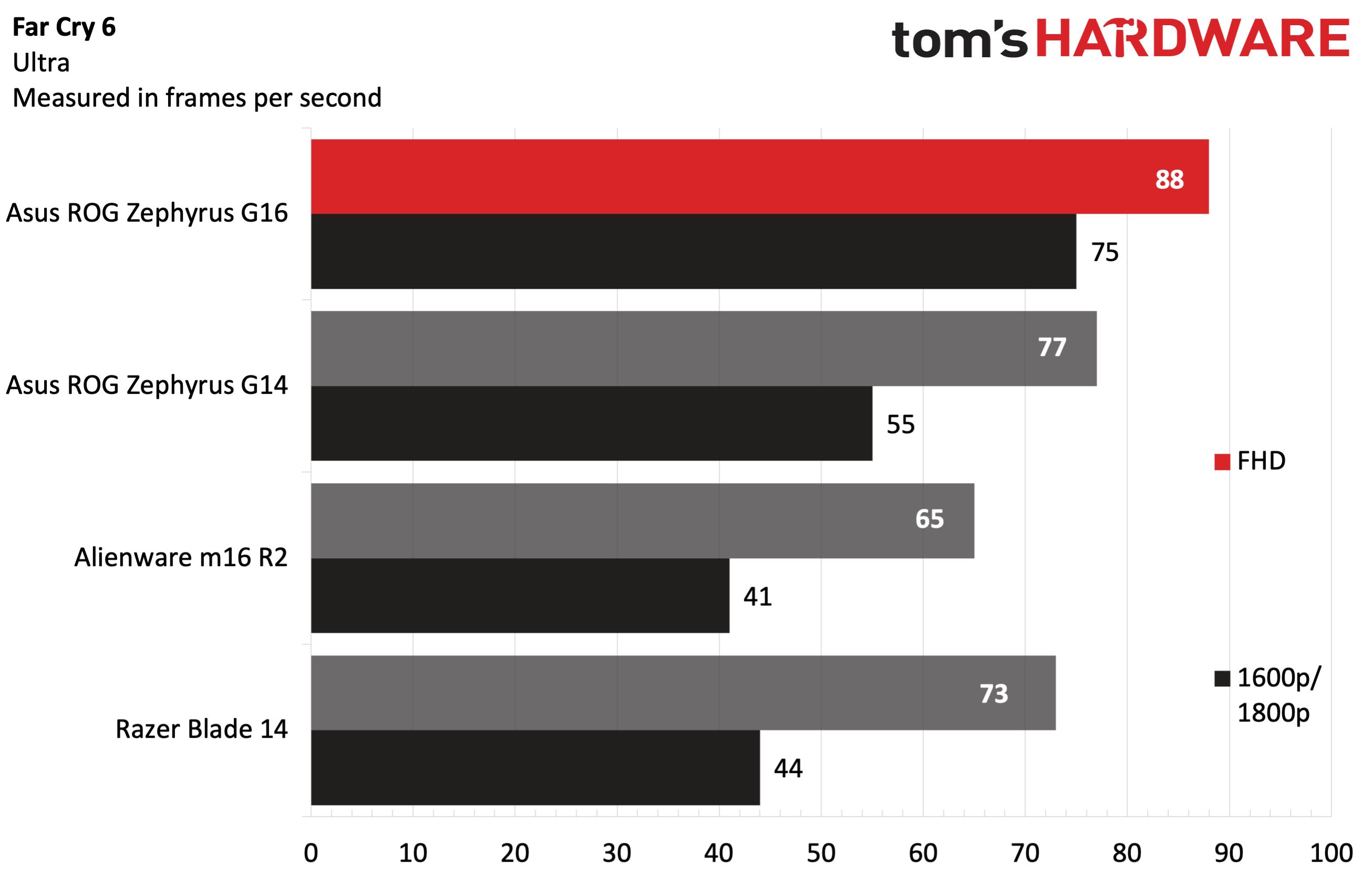
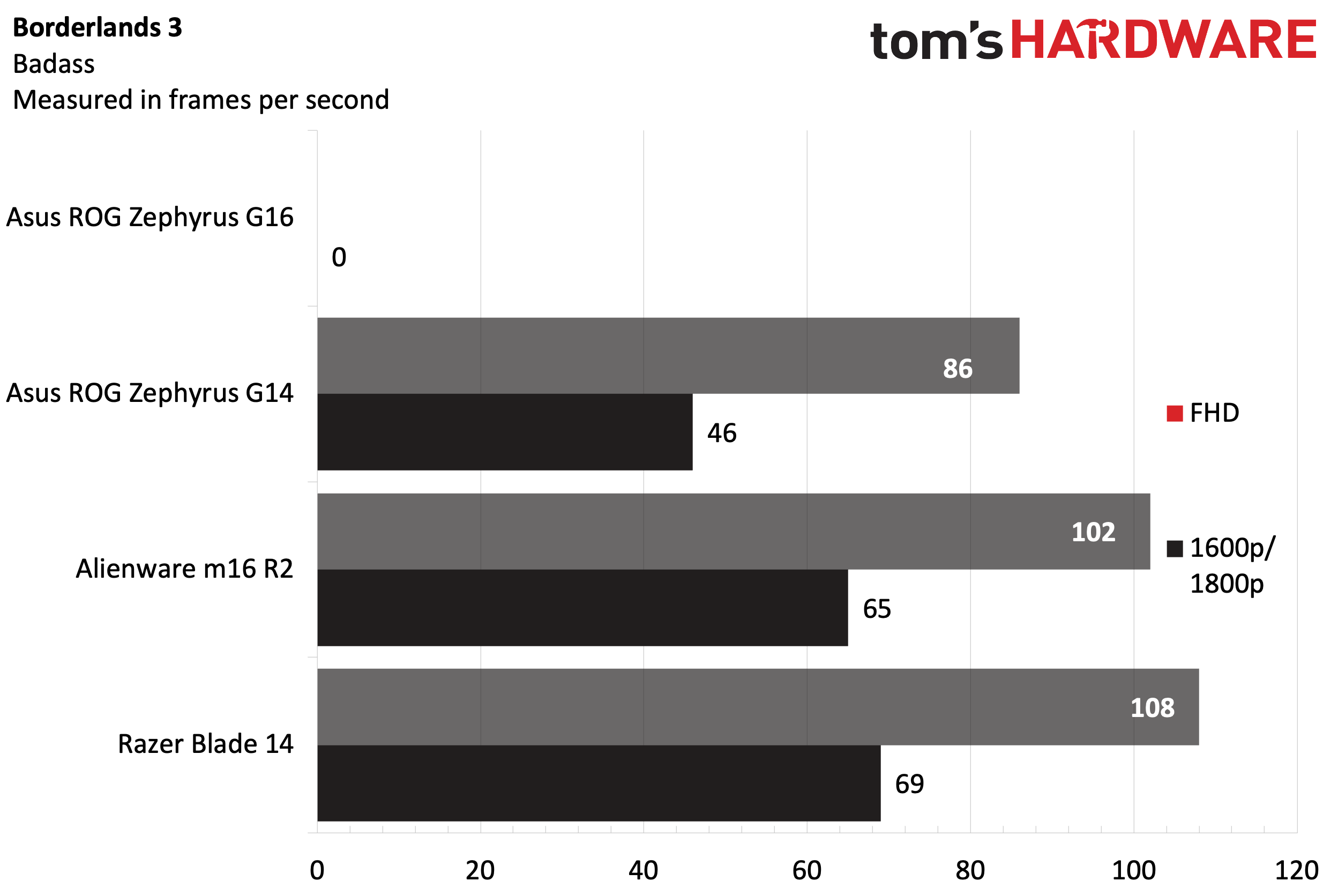
The ROG Zephyrus G16 jumped out to an early lead in our Shadow of the Tomb Raider benchmark (Highest settings), with 125 fps at 1080p and 85 fps at 1600p. The Blade 14 came in second place, with 114 fps and 78 fps, respectively.
Moving to the Cyberpunk 2077 benchmark (Ray Tracing Ultra settings), the ROG Zephyrus G16 slipped slightly behind the Blade 14 at 1080p (41 fps versus 42 fps), but the two laptops swapped positions at 1600p (24 fps versus 23 fps). The m16 R2 was also in the mix, hitting 40 fps at 1080p and 22 fps at 1600p.
The Far Cry 6 benchmark (Ultra settings) saw the ROG Zephyrus G16 achieve 88 fps at 1080p, 11 fps higher than the second-place ROG Zephyrus G14. However, the margin of victory was even more remarkable with the resolution cranked to 1600p. The ROG Zephyrus G16 barely missed a step, falling to 75 fps at 1600p, while the m16 R2 and Blade 14 were hovering in the low to mid-40 fps range.
The ROG Zephyrus G16's winning streak turned on its head with Red Dead Redemption 2 (Medium settings). Surprisingly, the laptop only mustered 54 fps at 1080p, putting it in last place. However, its 41 fps at 1600p tied for second with the m16 R2.
We ran into a benchmark hiccup with Borderlands 3. This game has long been in our arsenal of benchmarks for gaming PCs, but the ROG Zephyrus could not give us reliable or consistent results. The game would either crash repeatedly or present benchmark results that were incomprehensible. We noticed the issue with multiple test units, and Asus even verified the problem with their in-house systems. We have not heard yet about what is causing the issue or if it will provide a fix later, but this game is effectively unplayable on the Zephyrus as of this writing.
We stress-tested the gaming system with the Metro Exodus benchmark using the RTX preset through 15 runs (which simulates roughly half an hour of gameplay). During the stress test, the CPU's performance cores ran at an average of 3.42 GHz, while the efficiency cores ran at 2.84 GHz and measured 172.7 degrees Fahrenheit (78.2 degrees Celsius). The GPU clocked at 1.39 GHz and a temperature of 160.5 F (71.4 C).
Productivity Performance on the Asus ROG Zephyrus G16
The ROG Zephyrus G16 that we tested came equipped with a Core 9 Ultra 185H processor, 32GB of DDR5x memory, and a 2TB PCIe 4.0 SSD.
The synthetic CPU benchmark Geekbench 6.2 saw the ROG Zephyrus G16 deliver single- and multi-core scores of 2,525 points and 14,588 points, respectively. The former was within a few percentage points of the other laptops in this test, while the latter opened a wider gap between the second-place Blade 14.
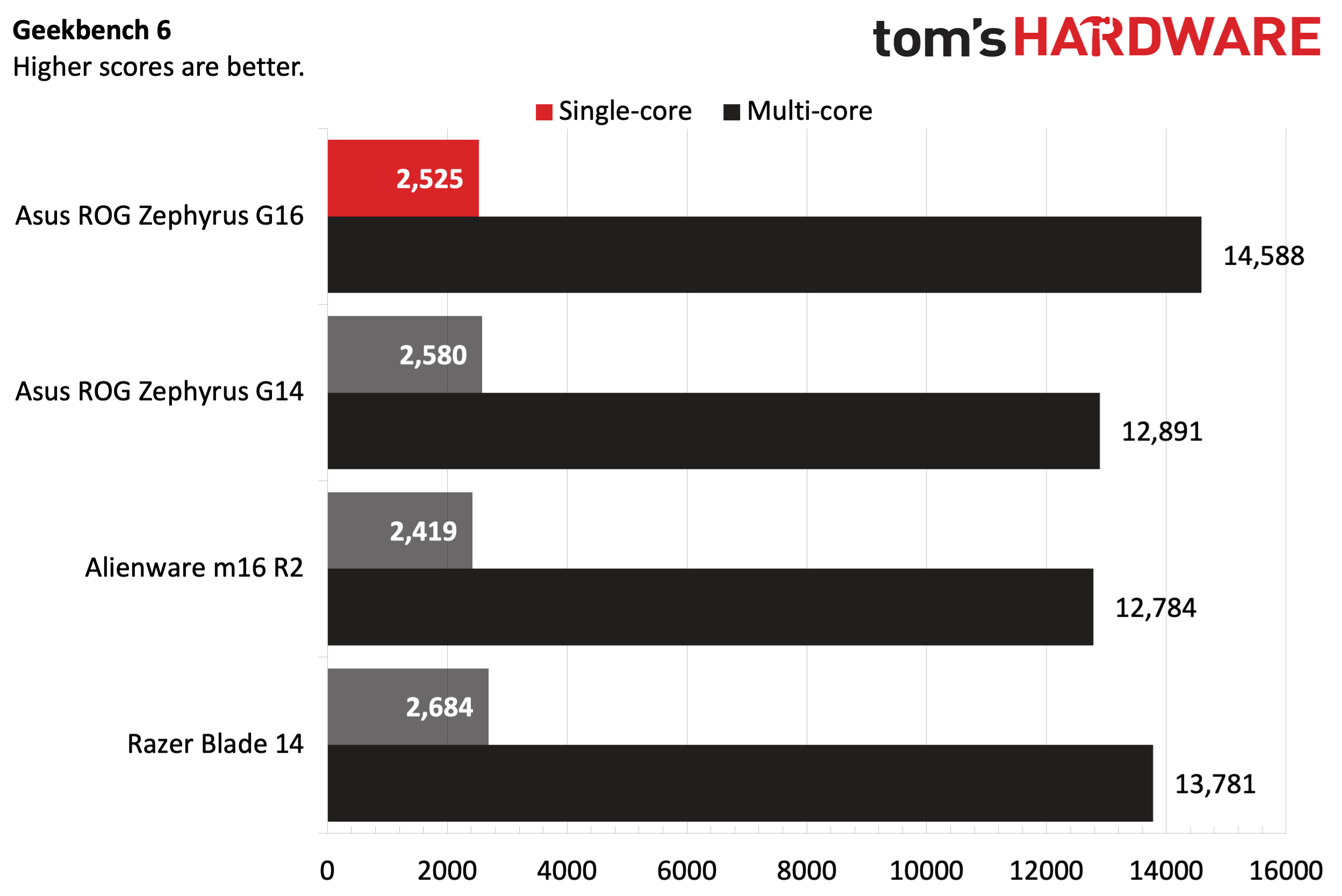
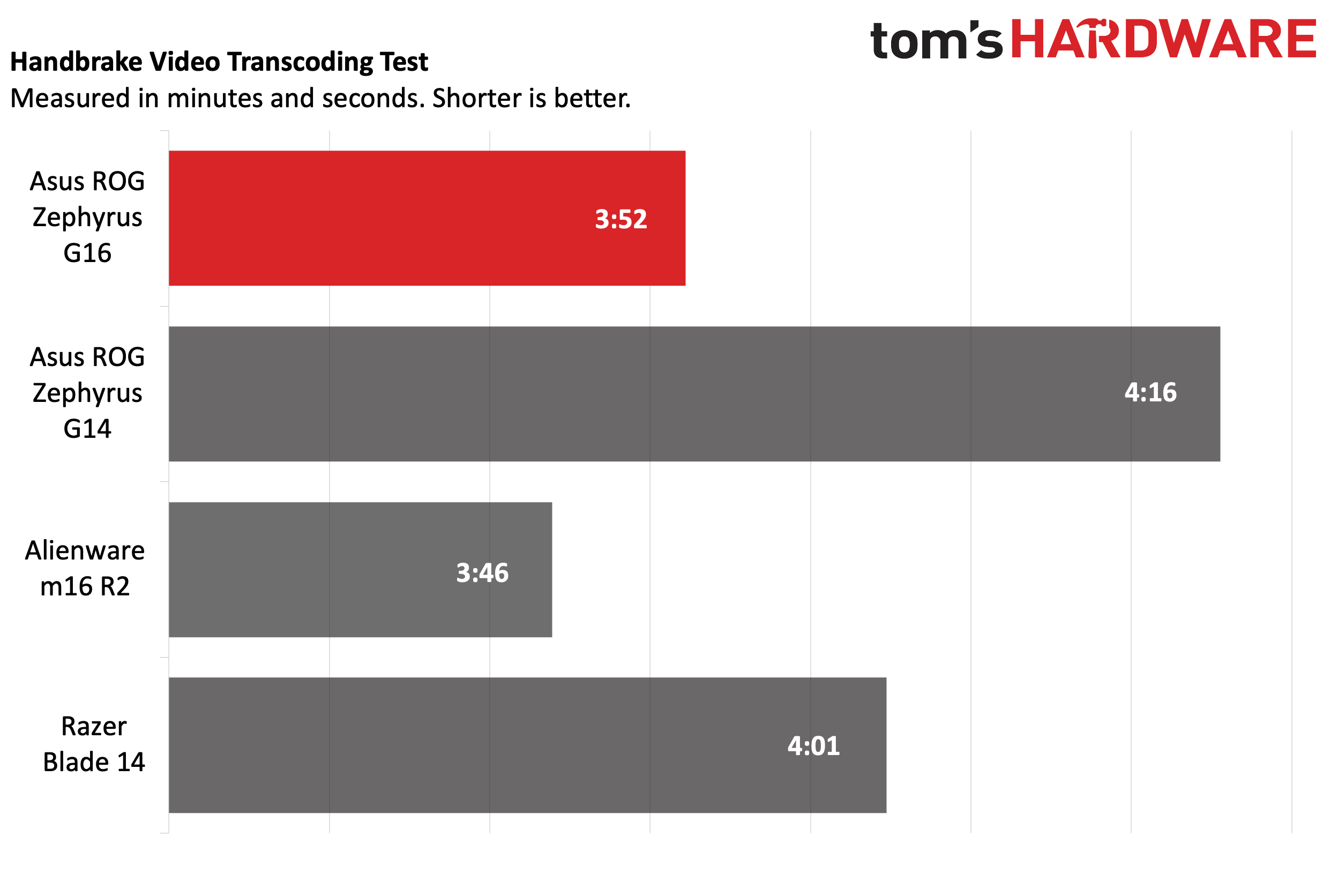
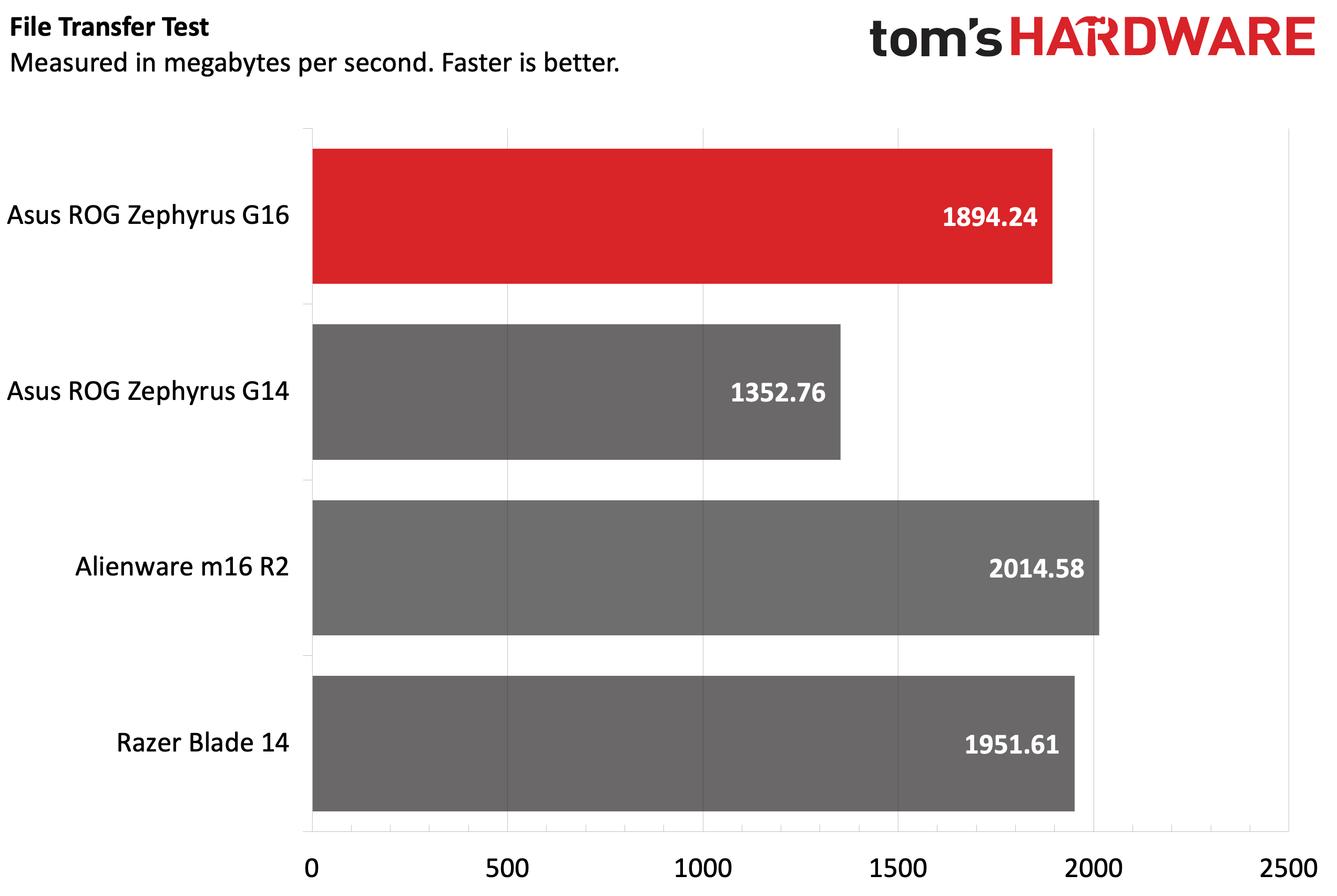
The ROG Zephyrus G16's 2TB SSD copied files at 1,894.24 Mbps in our 25GB file transfer test. In this grouping of overachievers, this was only good enough for third place behind the m16 R2 and Blade 14. The ROG Zephyrus G14 was the laggard in the group at 1,352.76 MBps.
Despite its Core i9 processor, the ROG Zephyrus G16 didn't take first place in our Handbrake test, which involves transcoding a 4K video file to 1080p. Instead, the m16 R2, with its Core Ultra 7 155H, took top honors at 3:46, or six seconds faster than the ROG Zephyrus G16. The Blade 14 finished the test in 4:01, while the ROG Zephyrus G14 took 4:16.
Display on the Asus ROG Zephyrus G16
Asus outfitted our ROG Zephyrus G16 review unit with a 16-inch OLED panel (2560 x 1600) with a 240 Hz refresh rate. That display is backed by a GeForce RTX 4090 discrete GPU. The display boasts a fast 0.2 ms response time, Nvidia G-Sync, and Dolby Vision HDR support. As with most OLED laptops on the market, the panel is covered in glossy glass, so you’ll have to contend with reflections.
The ROG Zephyrus G16's display performed quite similarly to the other laptops in our color testing. The display covered 78.4 percent of DCI-P3 and 111 percent of sRGB, which was nearly identical to the Blade 14 and not too far off from the ROG Zephyrus G14. Switching to our light meter, we measured 410 nits from the panel, putting it ahead of the ROG Zephyrus G14 and behind the Blade 14.
In practice, brightness was sufficient in nearly any environment. With the brightness set to about 33 percent, the screen was still readable and minimized the reflections from the overhead LED lights in my home office. Sitting outside, I cranked the display to 100 percent and was able to mostly minimize reflections from my house and nearby trees when sitting on my back porch.
I watched the Bad Boys Ride or Die trailer with great interest, as it’s been one of my favorite action film franchises since the original debuted in 1995. The trailer looked fantastic, from the reddish-orange explosions to the red of the iconic Skittles bag to the fluorescent glow of the green outfits during the club scene.
Keyboard and Touchpad on the Asus ROG Zephyrus G16
16-inch laptops often include a number pad due to the increased width of the chassis. However, perhaps wisely, as you’ll see in the next section, Asus dedicated more space to the audio subsystem. Like the ROG Zephyrus G14, the keyboard supports RGB key lighting, but it’s just a single-zone. Usually at this price you get per-key RGB.
While you don’t get a number pad, four additional keys are above the function row. There’s mute, volume up/down, and a dedicated button that opens the Asus Armoury Crate software utility. I visited my usual typing test website, keyhero.com, and recorded 83 words per minute with 92 percent accuracy. This is right in line with what I achieve with other laptop keyboards, given that I’m not the fastest typer around.
The large touchpad measures 6.1 x 4 inches and works great with the laptop. It has nice click feedback and a top-hinged design. Unlike touchpads that use haptics, the touchpad on the ROG Zephyrus requires more pressure to register a click the higher you press on it due to the hinge. If you want to disable the touchpad while using an external mouse, you can do so with the F10 function key.
Audio on the Asus ROG Zephyrus G16
Audio often feels like an afterthought with laptops. Manufacturers spend their budget cramming in the best CPUs, GPUs, memory, and storage, then throw whatever they have left over into the speaker system. Not so with the ROG Zephyrus G16. Asus includes six speakers — four 2W woofers and 2W two tweeters — in this chassis, and they sound amazing.
I fired up the latest Wolverine and Deadpool trailer and was blown away by every punch, gunshot, explosion, and F-bomb, not to mention the slow building of Madonna’s “Like a Prayer” in the background as the trailer progresses. There was real depth to the sound, and yes, actual bass – something that is critically lacking in most laptops. And that was just at 50 percent volume. Pushing the volume to 100 percent filled my home office with glorious sounds without distortion.
I also listened to the synth-heavy “Oh Lover” by Röyksopp, with its thumping bass and soaring vocals by Susanne Sundfør. Everything sounded so amazing that it seemed almost unbelievable that I was listening to laptop speakers. The only laptop sound system that comes close is in the 16-inch Apple MacBook Pro, and to my ears, the ROG Zephyrus G16 might even have an edge on that pricey machine. Asus includes the Dolby Access app to further tweak audio profiles (Game, Dynamic, Movie, etc.), but I found that leaving it in Dynamic provided the best balance in all types of content.
Upgradeability of the Asus ROG Zephyrus G16
There are 11 Torx screws on the bottom of the ROG Zephyrus G16 that must be removed to access the laptop’s interior. I initially only removed nine and was met with a bottom panel that wouldn’t lift off. I then realized that two additional screws were hidden under the rubber feet near the rear of the chassis. After I removed the feet (which are glued on with adhesive), I was able to locate the final two screws and access the interior.
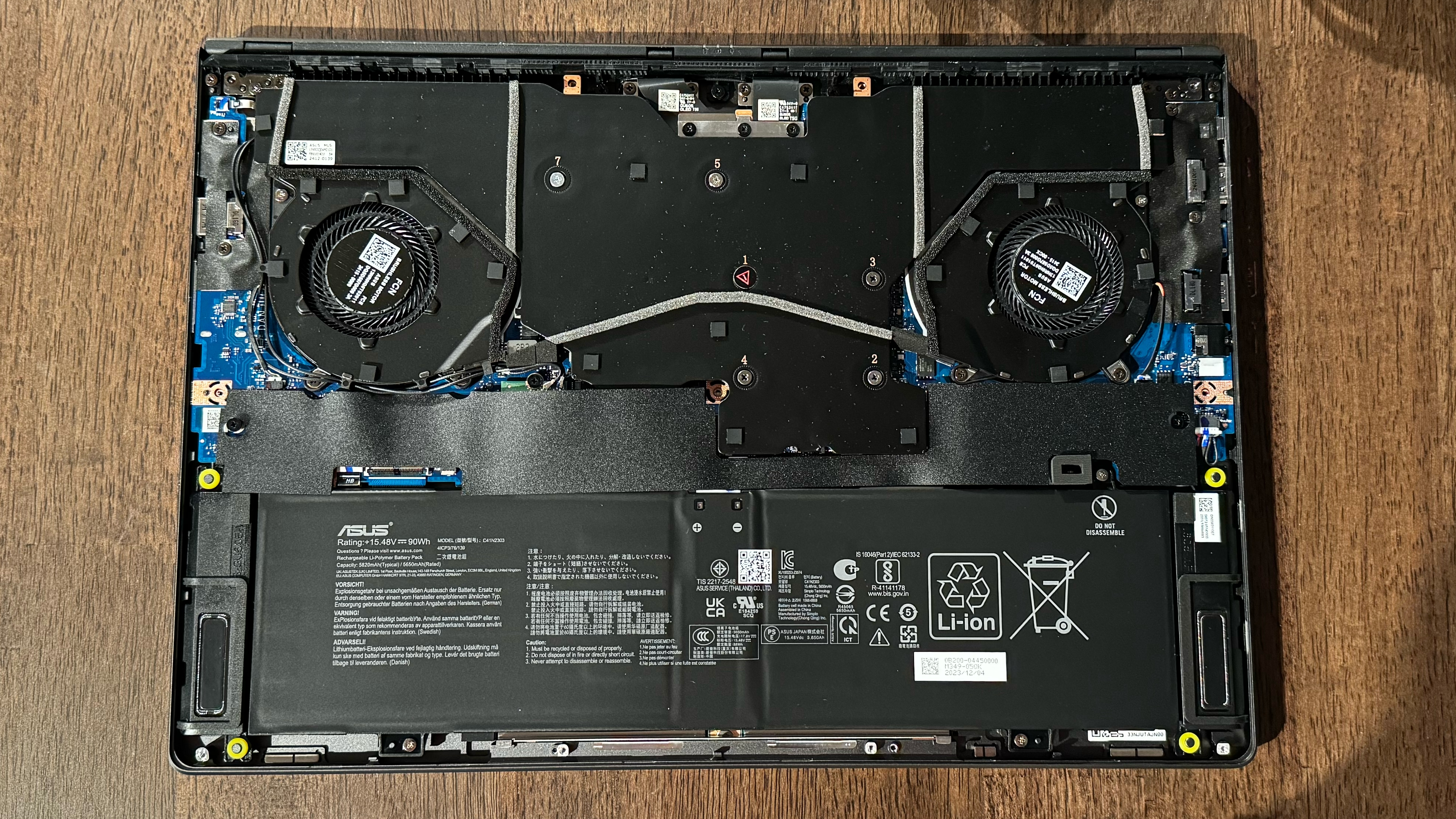
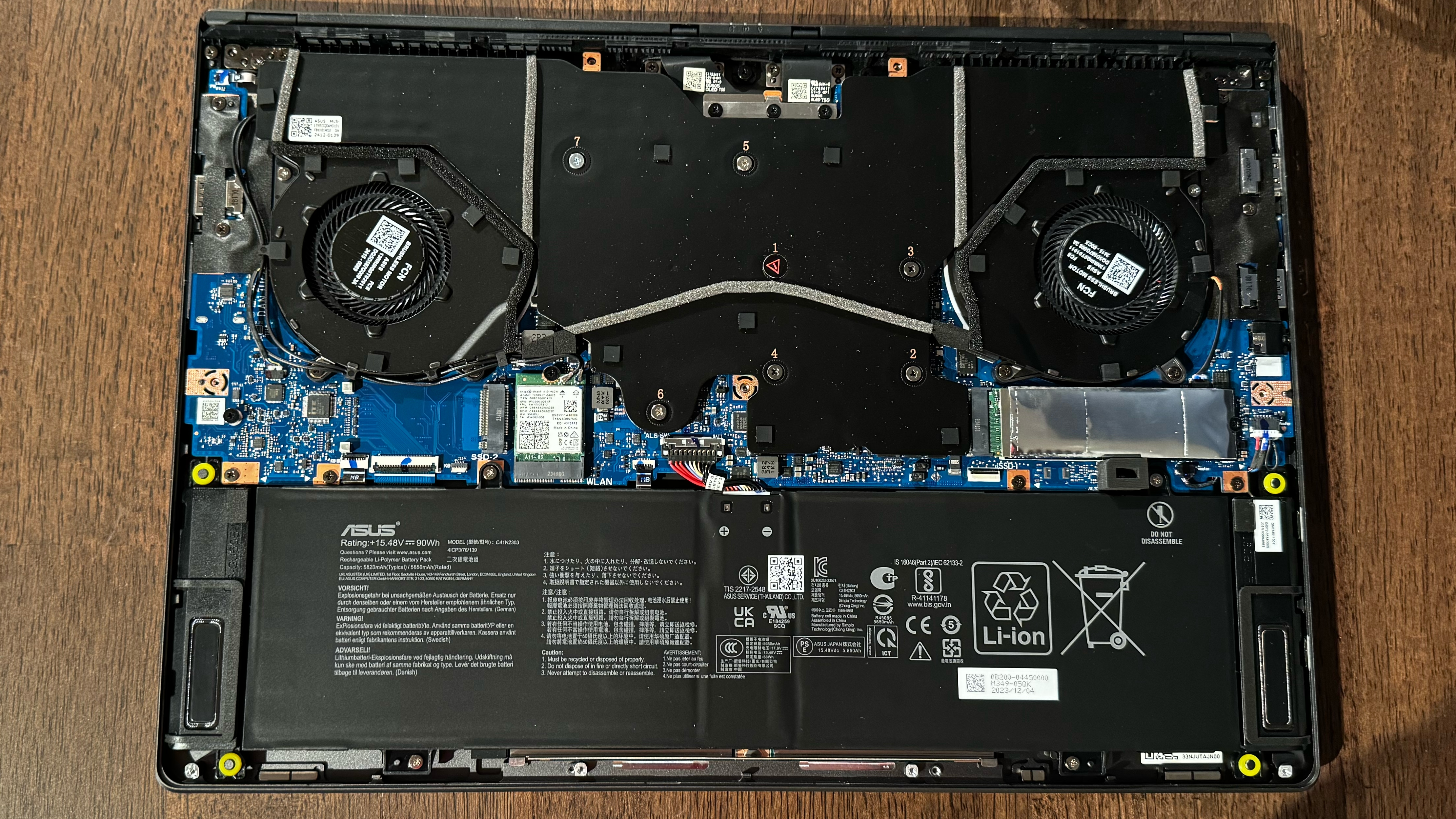
Once inside, there’s nothing much to see besides the large 90 Whr battery, the system fans, and a large, flexible black plastic shield. Removing the shield, which is affixed with adhesive, revealed the Intel Wi-Fi 6E/Bluetooth 5.3 combo card and the M.2 SSD – these are the only two upgradeable components. The RAM is soldered onto the motherboard, which is an increasingly standard practice by laptop OEMs today, even on some thin gaming laptops.
Battery Life on the Asus ROG Zephyrus G16
Our battery test involves web browsing, OpenGL tests, and video streaming over Wi-Fi with the screen set to 150 nits. The ROG Zephyrus G16 lasted for just over eight hours (8:03) during the test, placing it well ahead of the competition.
While we expected it to last longer than the 14-inch competitor, it also lasted nearly two hours longer than the 16-inch m16 R2.
Heat on the Asus ROG Zephyrus G16
The keyboard didn’t seem uncomfortably hot when running our Metro Exodus stress test, but the fans did kick into overdrive. They made their presence known. This is typical with gaming laptops – especially thin and light laptops trying their best to expel heat – so it shouldn’t be too surprising. You can always crank up the superb audio system or throw on a pair of the best wireless gaming headsets.
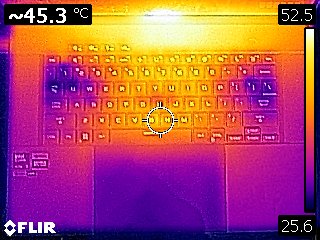
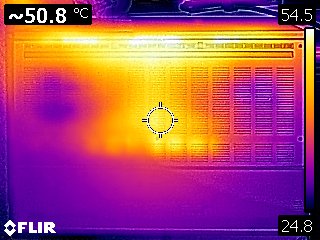
During the stress test, the hottest section of the laptop was the underside near the left vent, where we measured 135 degrees Fahrenheit (57.2 degrees Celsius). We measured 94.5 F (34.7 C) at the touchpad and 117.5 F (47.5 C) between the G and H keys.
Webcam on the Asus ROG Zephyrus G16
The ROG Zephyrus G16 uses a 1080p webcam, which has become standard issue for today’s laptops. Fine details were easily visible with the camera, like the stubble and small moles on my face. Colors also looked accurate and vibrant, while noise levels were low. Transitioning the laptop to a darker area of the room would initially result in increased noise levels until the software quickly kicked in to smooth out the artifacts.
My only complaint with the webcam is that any overhead lighting picked up by the camera washed out the picture and introduced significant halos. However, I was able to work around these annoyances.
Software and Warranty on the Asus ROG Zephyrus G16
Asus includes several of its utilities preinstalled on the ROG Zephyrus G16, including Aura Creator (which lets you create and modify RGB effects) and Armoury Crate (which is a one-stop shop for monitoring system vitals, setting power/performance profiles and downloading devices/software updates. Interestingly, MyAsus doubles up on some of the functionality available in Armoury Crate, which makes me question the need for both. You’ll also find GlideX, which is a cross-platform screen-sharing solution (if you register your PC with Asus, you can get a free one-year subscription to the service).
In addition to Asus's utilities, the usual Microsoft-sourced apps and shortcuts come preinstalled with Windows 11. That means there are links for Spotify, Luminar Neo AI Photo Editor, and Grammarly.
The ROG Zephyrus G16 comes from the factory with a one-year warranty.
Asus ROG Zephyrus G16 Configurations
Our ROG Zephyrus G16 review unit came equipped with an Intel Core Ultra 9 185H processor, 32GB of LPDDR5x-7467 memory, a GeForce RTX 4090 GPU, 2TB SSD, and Wi-Fi 6E/Bluetooth 5.3. The configuration costs $3,299 at Best Buy. It is also the flagship configuration for the ROG Zephyrus G16.
However, you can spend a lot less by going with a base configuration, which uses a Core Ultra 7 155H processor, 16GB of LPDDR5x-7467 memory, GeForce RTX 4050, 16-inch WQXGA IPS display, and a 2TB SSD. Unfortunately, we couldn’t find this particular configuration for sale, even though Asus lists it (and many others) on its website.
The cheapest we could find right now was a $1,999 Best Buy option with an RTX 4070, 16GB of RAM, 1TB of storage, with the same Core Ultra 9 185H and the 2560 x 1600 OLED screen.
Bottom Line
The ROG Zephyrus G16 is a bit of a mixed bag regarding performance. Its productivity performance was average despite a Core 9 Ultra 185H processor, a healthy amount of DDR5x memory and a fast 2TB SSD. Its gaming performance was also inconsistent. Even with an RTX 4090 onboard, it didn’t always outshine its competitors with lesser Core 7 Ultra processors and RTX 4070 GPUs. This is due in large part to the fact that the GPU is limited to 115 watts, whereas the same GPU in desktop replacement laptops maxes out at 175 watts. And it wouldn't run the Borderlands 3 benchmark, which Asus confirmed on its end.
On the other hand, the laptop is thin and lightweight with a bright, colorful, and accurate 16-inch OLED display and has one of the best speaker systems that I’ve heard in any laptop. It also offers a mix of ports to satisfy your connectivity needs.
With a price tag of $3,299 as-tested, I expect more from a high-end gaming machine – one that dominates laptops with inferior specs and has no compromises in game and software compatibility. Also, it would have been nice to have included Wi-Fi 7 at this price point rather than Wi-Fi 6E.
Asus still has a few performance bugs to work out with the ROG Zephyrus G16 to make it a true contender in the thin and light gaming laptop space.
MORE: How to Buy a Gaming Laptop
MORE: Best Gaming PCs
MORE: Best Ultrabooks and Premium Laptops

Brandon Hill is a senior editor at Tom's Hardware. He has written about PC and Mac tech since the late 1990s with bylines at AnandTech, DailyTech, and Hot Hardware. When he is not consuming copious amounts of tech news, he can be found enjoying the NC mountains or the beach with his wife and two sons.
-
Notton The entire 2024 Zephyrus lineup is a disappointment.Reply
Asus made them thinner, but I don't recall anyone asking for thinner by sacrificing cooling. -
SyCoREAPER Who the hell is going to buy a $3300 "it mostly works" laptop? Between their recent laptops, motherboards and repair scandals, Asus is basically Newegg, a has been company.Reply
Trust and consumers are no longer a prioriry, so they aren't a priority or trusted company for me. This article just seals the deal. -
Alvar "Miles" Udell Average and inconsistent performance, costs $3300, and STILL gets a 3.5/5 rating?Reply -
Sleepy_Hollowed I've been wary of ASUS engineering for laptops since like.... 2013.Reply
I had a friend whose gaming ASUS laptop just... died.
After extensively troubleshooting it, we narrowed it down to the GPU dying, and at that point, it was cheaper to just get a new, other vendor laptop.
This model has similar issues if the cooling is inadequate. -
SyCoREAPER Reply
IME most Zephyrus models have heating issues. How do I know? Because I've gone througbh multiple models, variations and sizes (because screw Best Buy and that's why I bought a warranty)Sleepy_Hollowed said:I've been wary of ASUS engineering for laptops since like.... 2013.
I had a friend whose gaming ASUS laptop just... died.
After extensively troubleshooting it, we narrowed it down to the GPU dying, and at that point, it was cheaper to just get a new, other vendor laptop.
This model has similar issues if the cooling is inadequate. -
Marble74 Reply
I have a G16 and love it for my games etc. but... Stalker 2 could not run, Diablo 4 my fingers would get hot on WASD, but the worst bit was the annoying ASUS lighting keeps popping off, not often but often enough when I need it. One of the main reasons I bought it was for the illuminated keyboards.SyCoREAPER said:IME most Zephyrus models have heating issues. How do I know? Because I've gone througbh multiple models, variations and sizes (because screw Best Buy and that's why I bought a warranty)
